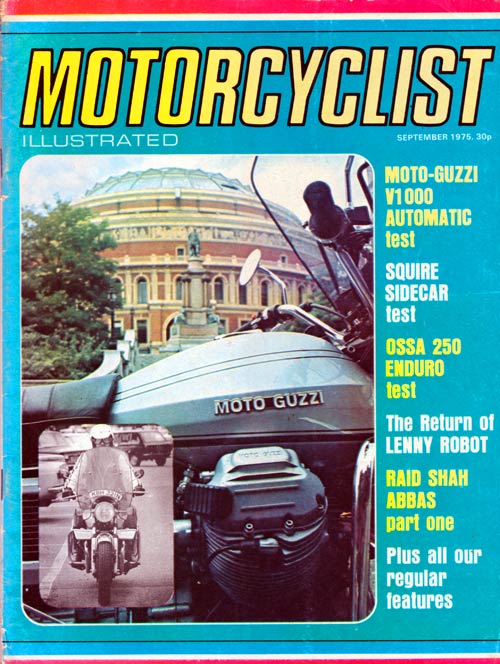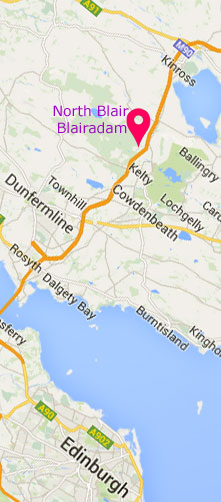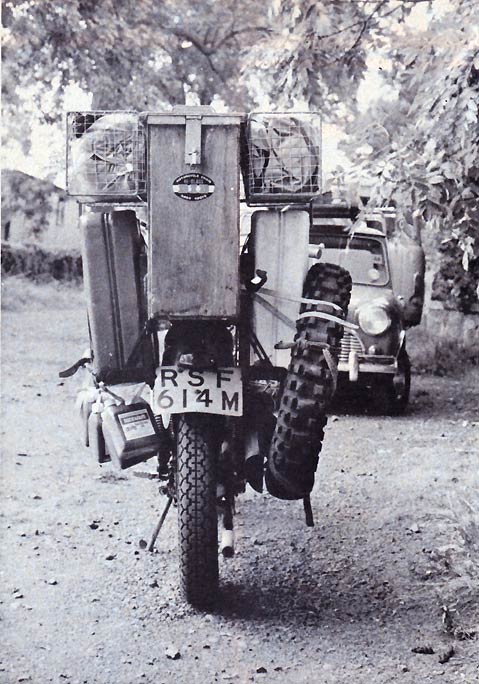
|
Motorcyclist Illustrated September, 1975
|

part 0
by Fergus Reilly
Ossa 250 Enduro Review
4216 klms
Kelty, Scotland
July 7th, 1974
(day -58 - 0 klms)
to
Kelty, Scotland
September 2nd, 1974
(day -1 - 4216 klms)
|

|

THE Ossa 250 Enduro is definitely built to take a hammering
off the road. Extremely low gearing and knobbly tyres make
traveling on tarmac tedious to downright uncomfortable
and positively nerve-racking in the wet; the lack of rubber in
contact with the road necessitates low speeds, causing each
kn0b’s impact with the road to be felt distinctly. In addition
the narrow seat becomes a blunt wedge, and after about six
hours the impression is of slow bisection to all but the maximally padded torso! |
it must be capable of getting me across Africa
|
 |
The bike carries the minimum street-legal equipment, but on the bike tested the horn ceased functioning after two
hundred miles, and the tin-plate and chewing-gum switch-
gear required much filing and waterproofing to ensure its
working, without having to stop and take a hammer to the
plastic toggles.
Speaking of electrics, the bike tested carried a rusting
ignition switch, ingeniously positioned to permit insertion of
the key only when dismounted and, if fitted with a key ring it
is switched off by the weight of the ring over bumps - highly
alarming and dangerous on country roads, let alone embarrassing on the rough. The high beam indicator was absent,
the kill button disconnected and the fuse drained about four
of the available six volts from the battery. Apart from that
the battery is virtually inaccessible, being surrounded by
large fibreglass sections, which admittedly look good and are
easily fabricated, but are detached with the greatest difficulty - requiring more tools than are supplied with the
bike. On the credit side, the 5in Italian sealed beam lamp is
excellent when the switches can be coaxed to transmit current to the filaments; there are pressure contacts for the
stoplight on both front and rear cables, but these did require
dismantling and trimming with rubber to allow effective
contact of the metal bits.
The bodywork is entirely of fibreglass and looks great, in
red and white on the tested '74 model better than most road
bikes. But, maintenance and removal is difficult since they
have tried to get away with too few pieces and the nut and
bolt fixtures require groping about before the battery is revealed.
The underseat compartment is of a suitable shape
for storing plasticine, but tools require careful juggling
before the seat can be replaced. The sections are unfortunately designed such that water runs into the underseat space
and thence to the battery compartment, both of which have
drainage holes drilled on the right, whilst the bike leans to
the left on its stand, leaving tools and battery sitting in up to
½in of water - the supplied tools were rusty within two days
of delivery in a reasonable dry Scottish May.
So the trimmings, most of which have been forced additions due to regulations, are not up to much, but then this
machine, in its intended use, is not meant to rely on them.
The motor is a very good unit, providing a wide powerband
which does not lack for horses anywhere. In fact it proved
almost impossible to stall the bike in first gear. The exhaust
gases pass along a business-like silencer, which is rather ugly
and ill-positioned; the chrome anti-burn frame permits
thigh-manifold contact in odd unguarded moments which
can be nasty! Fire is supplied via magneto and electric
pointless ignition in the form of a neat, compact unit beneath
the tank and leaves space for a pint of oil (provided you can
devise a simple method of attaching it which allows access
without a major strip).
Getting the bike going is not easy. When cold. the 32mm
Amal requires excess flooding, achieved by tucking the
overflow pipe up behind the exhaust whilst tickling. Then
the left side kick starter necessitates, dismounting before it
can be seriously attacked, a major balancing feat is required
if the bike is not on level ground, hanging over the bike
blanket-wise to reach the throttle whilst kicking the long
starter and avoiding an undignified sprawl on the ground.
To cap it off, the leg must be smartly removed left to avoid a
painful smack behind the knee as the starter snaps back and
snaps neatly away with a loud clang. In fact, on a cold morning, one can become crippled before getting the motor moving. |
Then there is the problem of stalling in heavy traffic -
well it is a good way of losing weight.
The single, 243.8cc two stroke piston-ported pot, once going. is a delight to hear and control. The Amal carb is simple
and easily adjusted to provide an adequate supply of go-
juice, although the pilot jet fitted appears to be suited mainly
for competition use as it has a tendency to produce clouds of
smoke or alternatively pre-ignition - after a work-out with
the adjusting screw hanging perilously far out. Nevertheless, when the appropriate mixture settings are selected the
motor is powerful, responsive and relatively quiet.
Although the gearbox contains a nifty direct drive in top
(fifth) it is difficult to work with grace! The 1:1 top ratio has,
I suspect, cost a few tight squeezes in the lower four which is
revealed in an almost task finding first when the engine is
hot. Neutral is no bother as there is one between each pair of
gears. Changing is not helped by a gear lever which lies 2
inches forward of a size ten boot, so that it is usually activated
at the hip; tiring on a long session when one finds oneself
repeatedly kicking hard, especially up to fifth and down to
second, with the sticky false neutrals between all gears. Moreover the lever is so positioned to take a clobbering on a left
hand fall pushing it into contact with the inspection plate.
This can be rectified easily with a shifting wrench and
preferably a vice! One wonders why a bike so obviously de-
signed for being dropped and thrown about should have such
a fantastic, solid ¼ in Dural crash plate and such a vulnerable
shift lever. Both gear lever and brake pedal are wired to the
frame.
Initially, I found the suspension springing inadequate, but
experimentation showed that the fourth setting of the five
available on the rear supports will carry 12 stones over most
terrain without bottoming. The front fork gave near perfect
performance after it was stiffened with 20/50 oil.
The double-loop, cradle frame is solid and in fact, purpose-built for ISDT type treatment. Although cut rather
short at the rear, it has excellent weight/strength characteristics. The wheels are similarly strong and light, but the
aluminium spoke nipples are short term and are likely to
seize and break the spokes after a while, far better to
sacrifice the two ounces and replace them with brass nipples
which would provide a lifetime commensurate with the rest
of the machine (bar the electrics).
Top speed is specified as 85mph, but vibration increases
after 50 mph, and with knobbly tyres it is difficult to imagine
conditions which would facilitate 80 plus in relative safety.
Once going, stopping is not really so easy as the 6.2in drum
front and rear are adequate for a controlled coming to rest
but inadequate for emergency stopping. The cables are all
protected at both ends by very neat lever dust covers and
mini-gaiters which is so sensible, neat and attractive that you
wonder why they aren’t standard equipment on most bikes.
Although the bike is clearly modeled on factory ISDT
entries its handling and low-speed capabilities would place it
in good stead for the Scottish, it is very happy to pick its way
up rocky gullies, climb boulders, plough through mud and
generally take a sedate stroll over the “hielandsâ€. Even a
cursory glance at the rubber mounted carburetor and mud,
dust and water-tight cover over the filter confirms that the
Ossa is built for rough country and rough treatment.
To sum up, the electrics are shocking, but the bike is
strong, simple, looks and feels reliable, handles superbly in |
 |
the whole spectrum of off-road conditions and is good value
fuel-wise (up to 120 mpg on the road). It needs little
modification for serious competition; in fact it is oriented to
such with little serious concession to the non-competitive
rider and at £529 (May 1974) you should think carefully — it
is not a trail bike, it is an Enduro. But what the hell, I am
taking my Ossa 250 to Africa! You can read all about the trip
in future issues of MCI. |
SPECIFICATION 250 E 73
- Engine two stroke single
- Bore and stroke 72 x 60 mm
- Displacement 250 c.c.
- Compression ratio 1 1 ,5:1
- Carburation 32 mm AMAL Rubber mounted
- BHP @ RPM 28 at 6,800 RPM (rear wheel
- Lubrication oil mist 5 %
- Gearbox 5 speed
- Gear ratios 5th 1:1, 4th 1:1.35, 3rd 1:1.82, 2nd 1:2.45, 1st 1:3.60
- Clutch multidisc wet
- Ignition motoplat electronic
- Brakes light alloy 163 mm diameter x 41 mm wide; water and dust protected
- Wheels and tires 4.50in x 18in, rear 3.00in x 21 in front
- Fuel capacity 13 litres 2.8 gals
- Weight 96 kg 212lbs
- Wheel Base 1.360 mm 53in
- Ground clearance 230 mm 8.75in
|
 |
|
|







